
Top 7 Cold Email Infrastructure Providers That Work in 2026
Something's broken with B2B cold email, and no, it's not your copywriting.
One in six marketing emails vanishes into spam folders, and for cold outreach, the numbers are worse.
Here’s what many sales teams miss: you can have laser-sharp targeting, killer messaging, and perfect timing. But if your cold email infrastructure is weak, you're burning thousands of dollars on campaigns that prospects will never see.
And that’s not just theory. Businesses are spending millions every year sending emails that never get seen. A 50% inbox rate versus 95%? That’s not a small gap.
That’s the difference between scrambling for replies and having a calendar full of booked calls.
And in 2026, with Gmail and Yahoo tightening their rules on authentication, infrastructure is an absolute non-negotiable.
So, if you’re serious about cold outreach, start with the right foundation.
And in this post, we’re covering the 7 cold email infrastructure providers that are actually worth using in 2026, because your emails deserve to be seen.
What Is Cold Email Infrastructure?
Cold email infrastructure is the technical backbone that determines whether your outreach lands in inboxes or gets flagged as spam. Think of it as everything happening behind the scenes when you hit send:
- The domains you send from (and whether they’re warmed up or fresh)
- Authentication protocols like SPF, DKIM, and DMARC
- IP addresses with good reputations (or at least not blacklisted)
- Send schedules and warm-up tools to keep you off spam radars
Most people assume their emails get delivered. Well, they don’t. (And no, even the best cold email marketing strategy won’t fix that if your infrastructure is broken.)
The problem is that even with great targeting and sharp messaging, your results will flatline if Gmail or Outlook marks your domain as untrustworthy. We’ve seen companies make that mistake, sending from their main domain, skipping authentication, then wondering why they never hear back.
The biggest shift hit in 2024 when Gmail and Yahoo cracked down on bulk senders. Anyone sending 5,000+ emails a day now needs proper DMARC records, or their messages get bounced. No inbox. No chance.
That change forced a lot of teams to rethink everything. Suddenly, cold email wasn't just about copy, but about the tech.
So if your campaigns are falling flat and you're not sure why, it’s worth taking a hard look at your cold email deliverability. That’s where most issues start and where most results come from.
The 4 pillars every cold email infrastructure needs
Your cold email infrastructure stands on four non-negotiable foundations.
1. Domain Strategy
Your main domain isn’t where cold emails should come from. Use secondary domains instead. Sending high volumes? Rotate across several to keep reputations intact. That way, if one gets flagged, your primary stays safe.
2. Authentication Protocols
SPF, DKIM, and DMARC tell mailbox providers you are who you say you are. Skip these, and your emails are treated as suspicious.
.webp)
3. IP Management
Using your own IP? Keep it clean and consistent. Shared IPs can work if the provider manages them well, but once you scale, dedicated IPs give you more control. The key is warming them up properly and watching for any dips in your email sender reputation.
4. Sending Infrastructure
This includes your email accounts, your warm-up process and whatever cold email software you’re using to manage sends. Remember to start slow, 5 to 10 emails per inbox per day, and build up over time. Sudden volume spikes are a great way to get flagged, especially if you haven’t taken time to warm up your email domain correctly.
Why Do You Need Cold Email Infrastructure?
Because the cost of getting it wrong is massive.
Bad infrastructure means wasted ad spend, missed quotas, and sales reps wondering why nobody responds.
When we work with new clients, we often find their deliverability sitting at 50-60%. They've been operating blind, assuming their emails reach inboxes when half are getting filtered out before anyone sees them.
And the gap between mediocre infrastructure and solid infrastructure shows up immediately in your metrics.
Higher inbox rates mean more opens.
More opens mean more replies.
More replies mean more booked meetings.
Most people blame the copy. Or the list. The math is simple, but most teams never connect poor response rates back to infrastructure problems.
So yes, infrastructure matters. A lot.
And now that you know what it takes to land in the inbox, let’s look at the providers actually helping companies pull it off in 2026.
The 7 Best Cold Email Infrastructure Providers in 2026
Not every provider tackles the same part of the problem.
Some specialize in warm-up tools. Others help with domains, inboxes or DNS setup. A few go all-in and manage the entire cold email system for you: strategy, infrastructure, monitoring and all.
Some are budget-friendly. Others are priced for teams with complex needs and big pipelines.
The right fit depends on:
- Whether you want to build and manage it yourself or fully outsource
- How many emails you’re sending each month
- Your tolerance for setup complexity and support delays
A provider can be “great” and still not right for your team. This breakdown covers strengths, weaknesses and use cases, so you can pick what actually fits, not just what sounds good.
Let’s get into the ones that actually deliver in 2026.
Hypergen
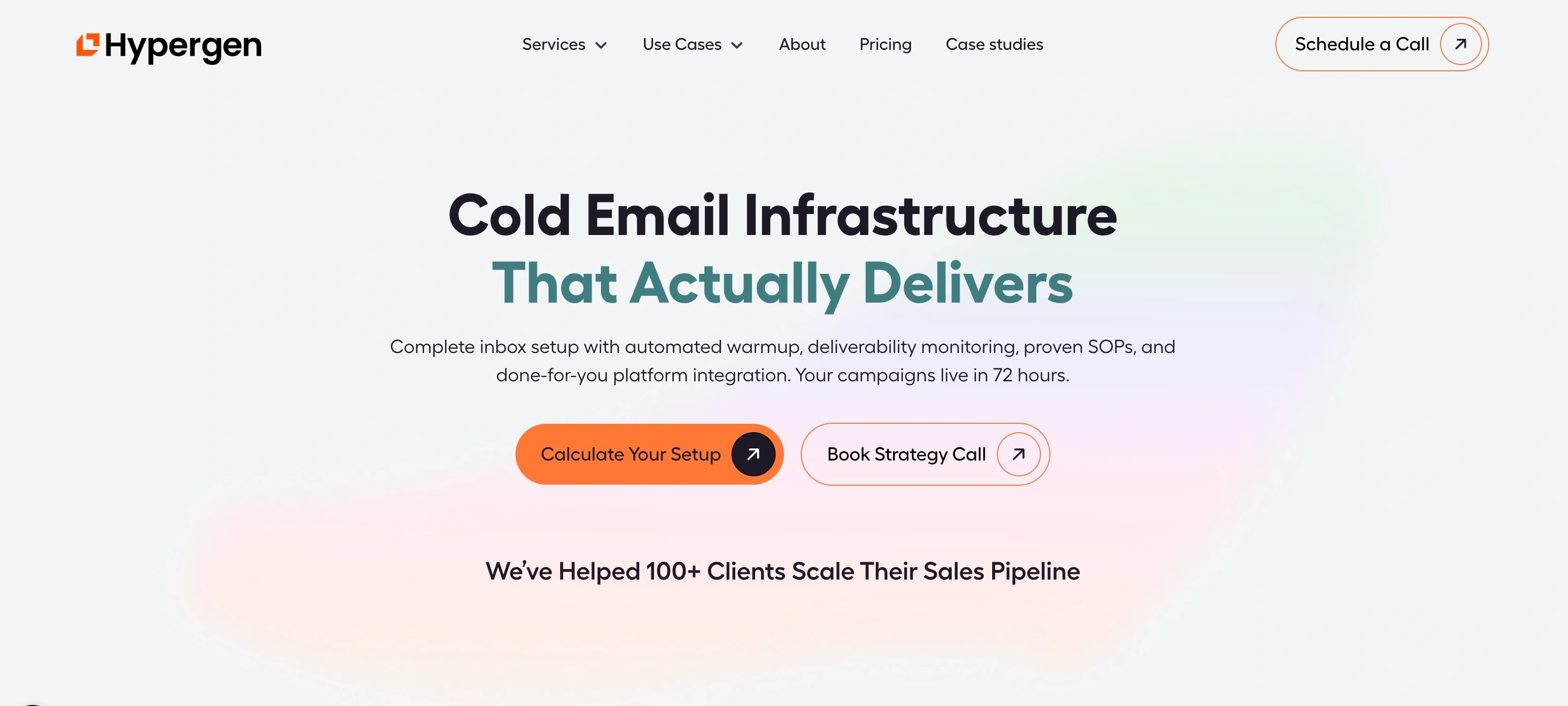
Yes, we’re putting ourselves first, and here’s why.
We debated saving this one for later in the list, but the truth is, if you're looking for speed, reliability and hands-off execution, this is where most teams end up.
Hypergen offers a fully managed cold email infrastructure setup that takes care of everything: domain sourcing, DNS records, inbox creation, warm-up, monitoring, and deliverability protection.
You get a complete inbox infrastructure live within 72 hours, with domains fully warmed and ready for campaigns.
We handle everything:
- Domains and inboxes
- Authentication (SPF, DKIM, DMARC)
- Warm-up
- Monitoring
- Monthly performance reviews
If it affects cold email performance, we’re on it.
And with our partnership with Plusvibe, we can layer AI-powered personalization and enrichment on top. So it’s not just about getting into inboxes, it’s about getting replies too.
Our favorite features:
- You’re live in 72 hours, fully warmed and ready to go ⚡
- Deliverability monitoring runs in the background to catch red flags early 🧠
- We handle domain management so you never touch a DNS record 🙌
- Pro accounts get Slack support for fast answers from real humans 💬
- We set up the accounts in your platform of choice (whether Smartlead, Instantly, PlusVibe, or another one) 🧩
Best fit for:
Why we made the list:
We know this space inside out, because we live in it daily. Hypergen exists to solve this exact problem. So yes, we’re biased, but if we weren’t confident in our own infrastructure, we wouldn’t be trusted by clients sending thousands of emails a day.
Trulyinbox
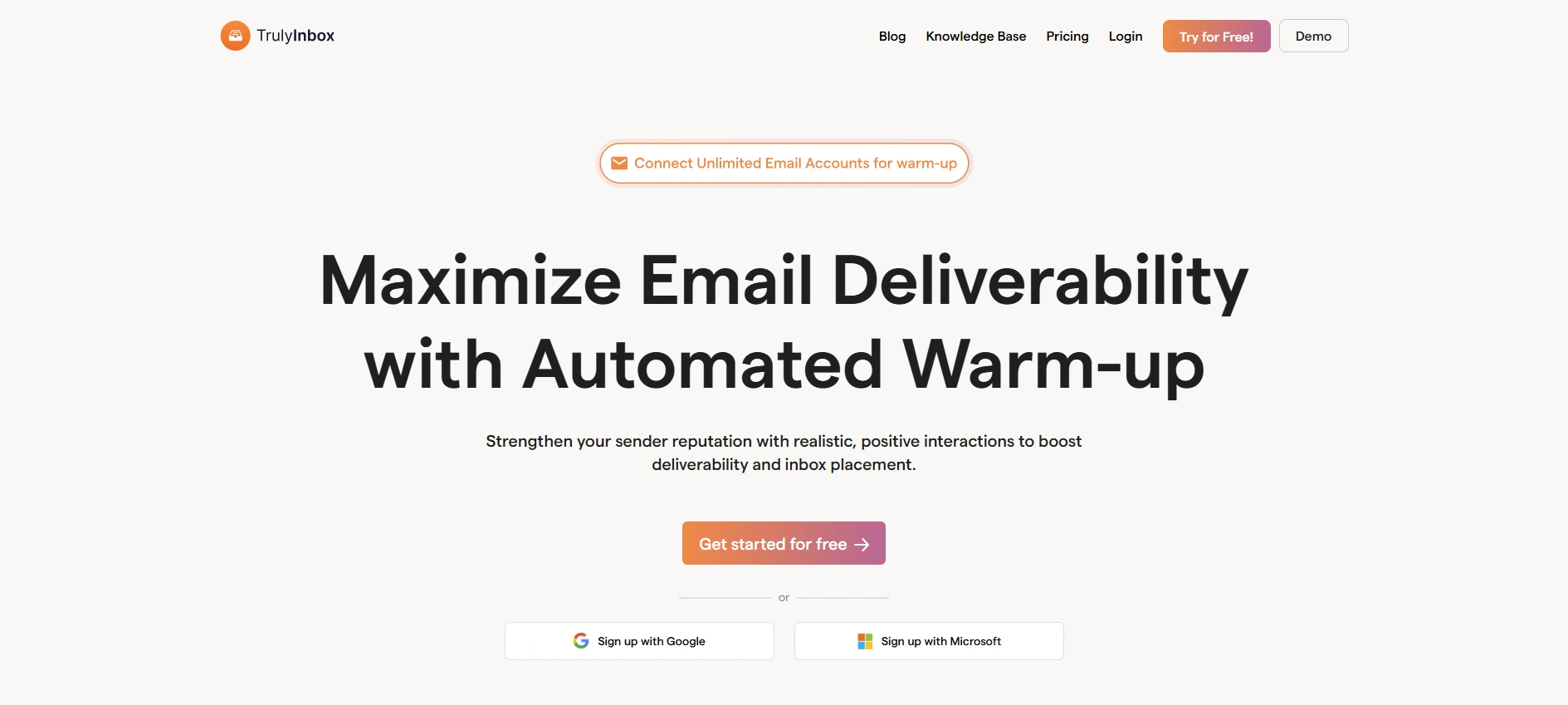
TrulyInbox is a focused warm-up tool designed to do one job really well: keep your emails out of spam. It connects to your existing inboxes and runs automated warm-up cycles that simulate real user activity (sending, opening, and replying), so your sender reputation climbs steadily over time.
It doesn’t manage domains or handle setup from scratch, but if you're already operational and just need to improve deliverability fast, this tool does exactly that.
Our favorite features:
- Customizable warm-up speed and reply rate gives you control over how aggressive it is ⚙️
- The unlimited accounts plan is a win for agencies juggling multiple clients 💼
- There’s a free tier if you want to try it before you buy it 🆓
- Clean interface keeps things user-friendly, even for folks without a tech background 🖱️
Best fit for:
Smaller teams and agencies that want a no-fuss way to warm up inboxes. Especially useful for budget-conscious teams that don’t need full deliverability suites.
Why it made the list:
TrulyInbox is one of the simplest and most efficient ways to improve cold email deliverability when your infrastructure is already live but needs a boost.
Maildoso
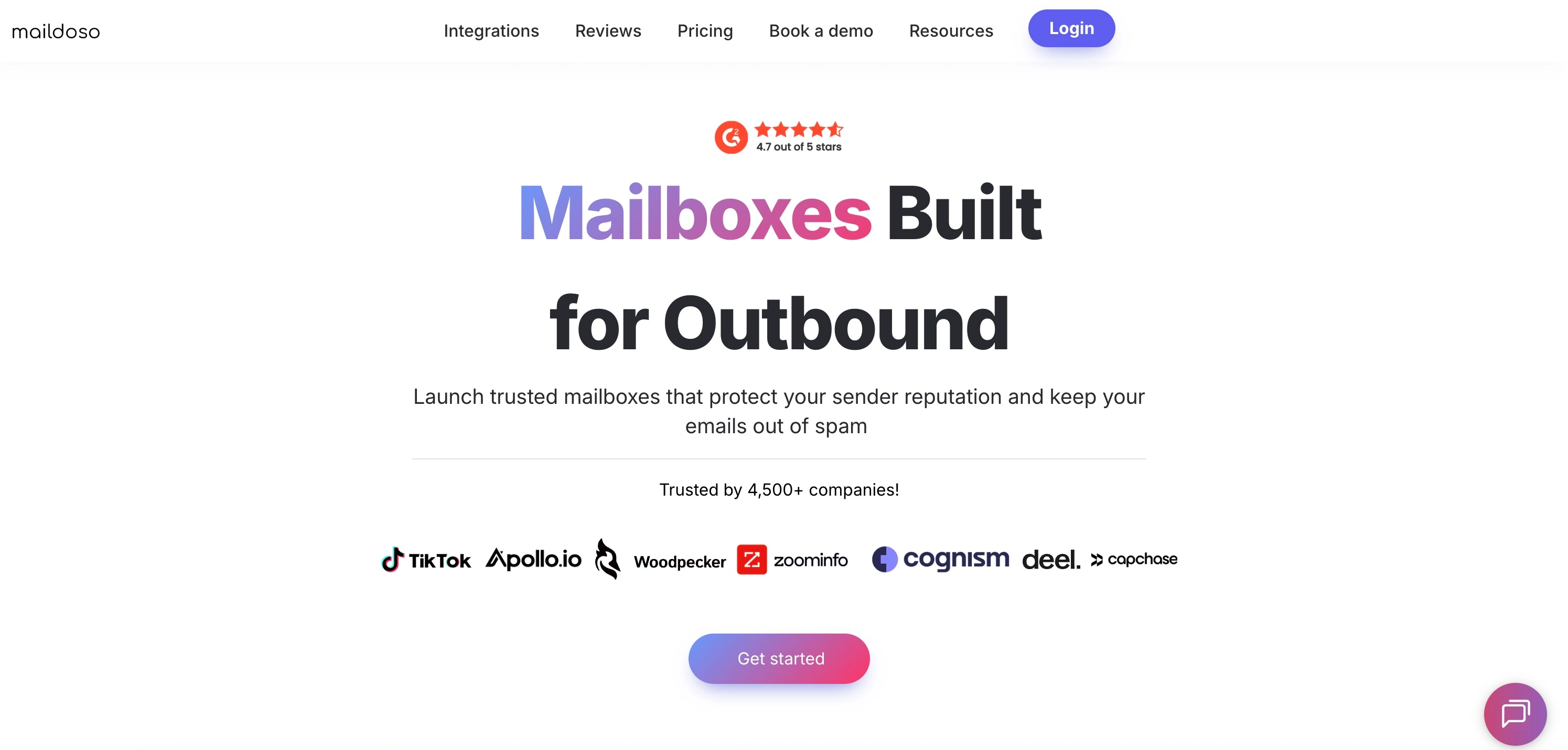
Maildoso offers an all-in-one infrastructure solution built for serious volume. From custom domains to pre-authenticated inboxes, everything is fully automated so teams can launch outbound campaigns without spending weeks on setup.
You can generate hundreds of ready-to-send accounts in minutes. Every inbox comes with SPF, DKIM, and DMARC set up, and there’s optional AI-powered warm-up if you want to scale safely from day one.
Our favorite features:
- You get free domains with your subscription, so there’s nothing to buy or manage upfront 🌐
- SPF, DKIM, and DMARC are auto-configured, with DNS handled behind the scenes 🔐
- One dashboard controls every inbox, whether you're running five or fifty 🖥️
- Burn a domain? They’ll replace it fast so campaigns keep running 🚀
Best fit for:
Agencies, B2B platforms, and cold email pros who need to launch and manage large-scale campaigns fast without compromising deliverability.
Why it made the list:
Maildoso is built for speed and scale, giving you everything you need to launch high-volume cold email operations without the usual setup pain.
Mailscale

Mailscale is purpose-built for high-volume cold email campaigns that need precision and control. From auto-generating inboxes to rotating domains and monitoring spam signals, the platform helps agencies and enterprise teams send at scale without putting deliverability at risk.
It’s all about sending smarter, not just more. With performance consistently above 90% inbox placement, Mailscale makes volume feel less risky and more manageable.
Our favorite features:
- Instantly creates hundreds of inboxes and domains for large-scale campaigns 🏗️
- Smart domain rotation evens out volume to avoid red flags 🚦
- Central dashboard shows real-time inbox placement and sender reputation 📊
- Easy SMTP and API integration with popular outreach tools 🔌
Best fit for:
Advanced teams, performance marketers, or enterprise senders who treat cold email like a growth lever, not a side task.
Why it made the list:
Mailscale delivers serious scale and stability, offering deep insight into performance so teams stay ahead of spam issues while pushing volume confidently.
MailReach

Mailreach gives you a real-time look into your cold email health. It’s built for teams that want to keep their sender reputation clean without guessing. With continuous warm-up, spam testing, inbox placement tracking, and blacklist monitoring, you can stay ahead of deliverability issues before they become problems.
It doesn’t handle domain creation or setup, but once you’re live, it’s a smart way to keep your sending reputation on track.
Our favorite features:
- Daily warm-up with real inbox-to-inbox interactions that look human 👥
- Live dashboard shows where your emails land: inbox, spam, or promotions 📈
- Spam checks and blacklist alerts flag risks early 🛑
- Plans scale from solo senders to full agencies managing dozens of inboxes 🧩
Best fit for:
Teams that already have their sending stack set up but want smarter warm-up and visibility into deliverability issues. Ideal for seasoned cold emailers.
Why it made the list:
It’s the go-to tool for experienced senders looking to optimize every part of their deliverability stack. It doesn’t do everything, but what it does, it does extremely well.
Warmup Inbox

Warmup Inbox is one of the longest-running tools in the cold email space, known for helping senders build and maintain solid reputations. It connects directly to your inboxes and runs warm-up cycles using a global network of real accounts: sending, opening, and replying just like a real user would.
It’s easy to set up, low-maintenance once live, and gives you consistent visibility into deliverability performance.
Our favorite features:
- Automated warm-up with human-style sending and reply behavior 🤝
- Real-time tracking shows where your emails land across inboxes 📬
- Built-in SPF and DMARC tools simplify domain authentication 🧩
- Daily deliverability score shows how inbox health is trending 📊
Best fit for:
Agencies and businesses that want a reliable warm-up solution across multiple inboxes without dealing with overly technical setups.
Why it made the list:
Warmup Inbox strikes a strong balance between usability and accuracy, making it a go-to for teams that want a proven way to build reputation and avoid spam folders.
Lemwarm
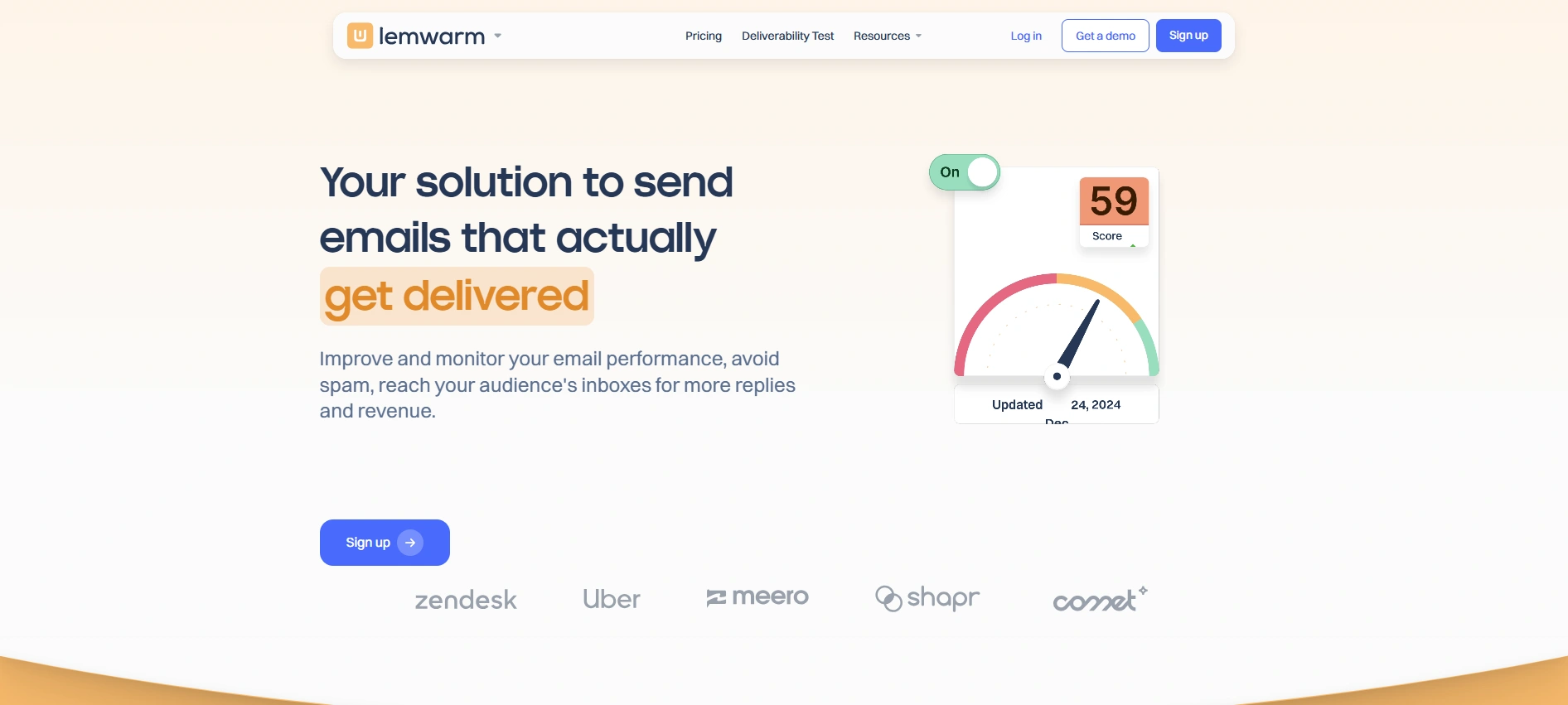
Lemwarm helped shape the warm-up category, and it’s still going strong. Built by the team behind Lemlist, it boosts deliverability by simulating natural email behavior across a large internal network. Emails are opened, replied to, and marked as important to build sender trust without manual work.
It’s simple to use, especially if you're already using Lemlist for outreach, and everything integrates smoothly across campaigns.
Our favorite features:
- Warm-up gradually mimics human engagement with sending, opening, and replying 📨
- Integrates directly into Lemlist’s multichannel campaign builder 🔄
- Customize reply rates, daily volumes, and domain types for more control 🎛️
- Real-time tracking of sender reputation and deliverability performance 📊
Best fit for:
Teams already running Lemlist campaigns who want warm-up built right into their outreach flow.
Why it made the list:
Lemwarm keeps things simple, integrated, and reliable. If you’re already in the Lemlist ecosystem, this tool makes deliverability part of your daily workflow without adding more complexity.
Side-by-Side: Which Cold Email Infrastructure Provider Fits Your Needs?
Now that you’ve seen what each provider brings to the table, it’s easier to spot what fits your use case and what doesn’t.
Not every team needs the same setup. Some want to move fast. Others want full control. And some just want the damn thing to land in the inbox without babysitting DNS records all week.
Here’s how the top 7 cold email infrastructure tools compare across the stuff that actually matters (domain management, deliverability strength, setup speed, support quality) and who they're best suited for:
Your Cold Emails Deserve Infrastructure That Actually Works
If there’s one thing this guide should make clear, it’s this: cold email isn’t just about what you say, it’s about whether you’re even seen.
The data from 2025 makes it clear: up to 17% of cold emails never reach inboxes, and more than 60% of businesses have seen revenue dip because of poor deliverability. Not because the offer was weak, but because the setup was.
Fixing that starts with treating infrastructure as seriously as you treat your messaging:
- Authenticate your domains
- Warm your inboxes before sending
- Monitor performance regularly
- Avoid shortcuts that nuke your sender reputation
Whether you need a fully-managed solution like Hypergen or prefer a mix of DIY tools and monitoring platforms, what matters is that your setup is intentional and reliable. Deliverability isn’t something you “hope” for, it’s something you build.
If you’re wrestling with cold email infrastructure, or just tired of guessing what’s going wrong, this is the kind of stuff we fix every day. Whether you need a fresh setup or want to scale safely across dozens of inboxes, we know how to get you there without breaking your deliverability.
Because the only thing worse than getting ignored is never being seen at all (and yes, it happens way more than people think.)
Frequently Asked Questions About Cold Email Infrastructure
What is cold email infrastructure and why is it important?
Cold email infrastructure is what makes sure your emails actually show up in someone’s inbox. It covers everything behind the scenes: SPF, DKIM, DMARC, warmed-up domains, IP management, and inbox setup. Without it, mailbox providers treat you like spam (even if your offer is gold).
Which tools are essential for building cold email infrastructure?
You’ll need three things: authentication, warm-up, and deliverability monitoring. Tools like Hypergen, TrulyInbox, and Mailreach cover those bases with features like domain rotation, inbox testing, and sender reputation management. The best setup depends on how much you're sending, but every cold email sender needs the basics in place, no exceptions.
How do I improve cold email deliverability?
Deliverability gets better when your setup, your sending habits, and your engagement signals are all aligned. That means properly authenticating your domains, sending gradually instead of blasting, and keeping your complaint rate below the 0.3% threshold enforced by Gmail and Yahoo. It also means checking regularly to make sure your emails are actually hitting inboxes.
Which metrics should I track for a healthy cold email infrastructure?
Inbox placement is the one to watch first: healthy campaigns usually land 90 to 95% of emails in the inbox. Your bounce rate should stay below 2%, and spam complaints need to stay under 0.3% if you want to avoid reputation issues. You should also monitor your domain reputation, check blacklists, and keep an eye on reply rates to track engagement. If anything starts slipping, especially your inbox placement or spam score, it’s time to pause and reassess before the damage spreads.
Don’t miss these
Get Your First Lead This Month
14 days to get started. 7 days to get your first lead on average.








.png)
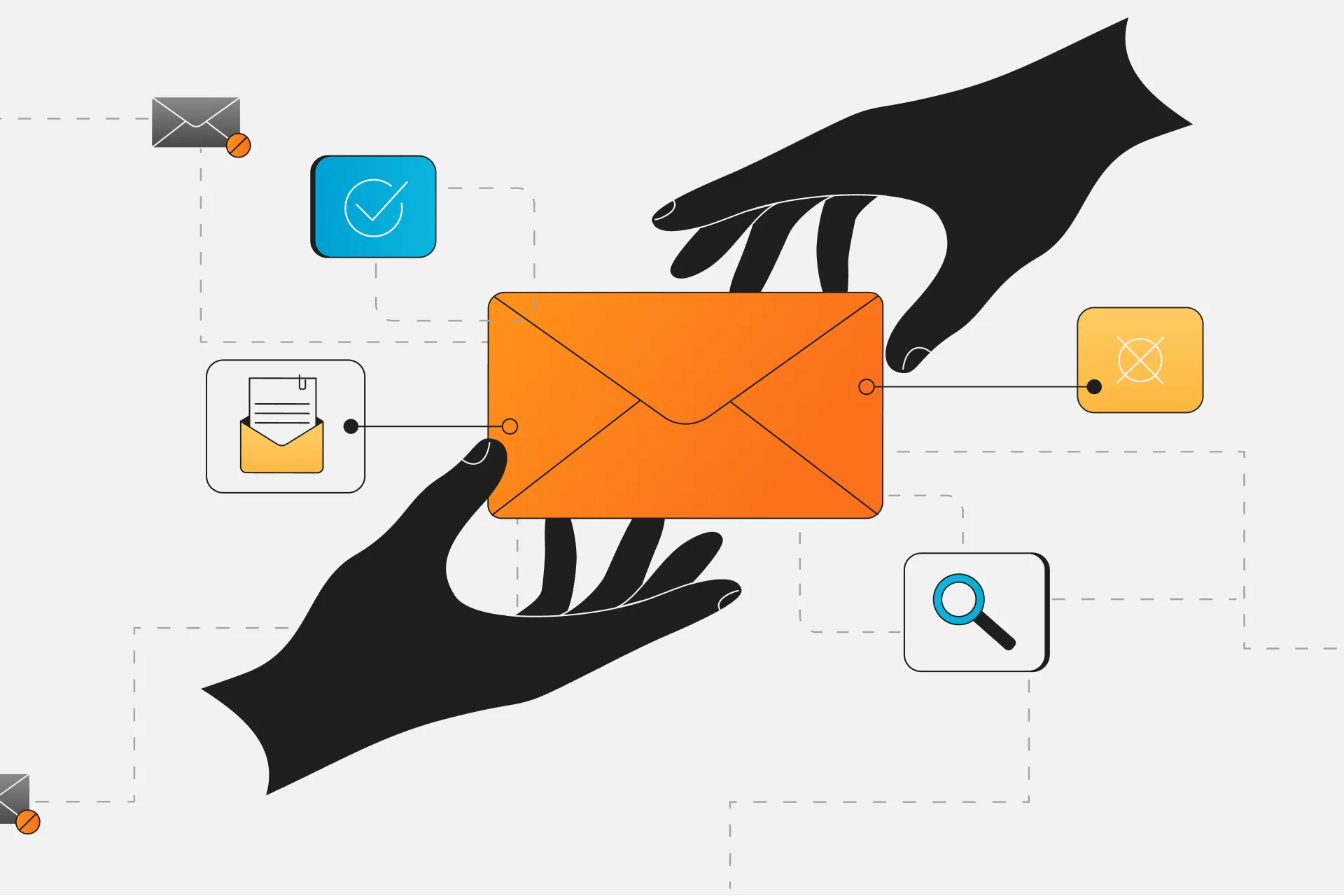
%20(1).webp)
